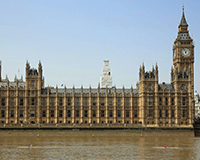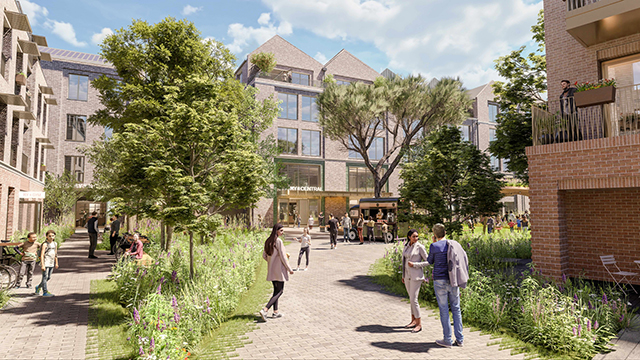It has been described as the Glastonbury for political obsessives. And one thing’s for sure – there will be plenty of mud; but just of the slinging kind, not the stuff that gets into your wellies.
Party political conference season has kicked off and, for the next three weeks, expect rambunctious key speeches, press junkets, and even the occasional celebrity at the fringe festivals.
With just eight months to go before the general election, this year’s gathering of the clans will be crucial. So what can property expect, what does it want, and who would be the industry’s favourite to be holding the keys to Number 10 next year?
Looking through the history books, it is little surprise that the Conservatives are property’s best friend (see graphic). Research compiled for Estates Gazette by planning experts Daniel Watney shows that the Tories’ average annual output while in power has placed them top for housing and social housing performance, as well for the number of planning applications. Widen that to include their leading role in the coalition and this is only strengthened by the way they have helped to increase the output value of construction (£74.7bn), and to deliver the greatest share of private housing (78%) and the most square feet of rateable space.
But it’s not all good news. There are signs that the number of decisions called in by the secretary of state –which had been dwindling – are picking up again (see graphic).
Jeremy Castle, director of Deloitte’s central London planning team, recalls the coalition government’s more relaxed stance. At the time, he was development director of Treasury Holdings in charge of the redevelopment of Battersea Power Station and was hoping to put an 8m sq ft development in a town centre of 500,000 ?sq ft. “We had the support of Wandsworth and the mayor and the government didn’t feel the need to call it in,” he says.
Admittedly, the recession helped to diminish the number of big applications, which has played a part in reducing call-ins. But Castle adds: “The government was also relaxed in its approach and seemed to be saying that if the local authority was happy, it was happy, and I suppose the policy was working. But recently it seems the politics is taking over a bit.”
Of course in recent years, the Tories have not been flying solo and, back in 2010, the coalition government was not short of a policy or two. The speed of change and sheer bulk of new policies pushed through has left many gasping for breath. “It’s quite extraordinary that they managed to push those policies through,” says Mark Brooker, associate in ES Group’s planning consultancy. “The Conservatives show no signs of fatigue in their drive ?to reform.”
Planning changes
Brooker rattles through a list of planning changes since the coalition took control. Clegg-Cameron kicked out regional spatial strategies and replaced them with localism, the NPPF, permitted development rights and the growth and infrastructure fund. It is consulting on making permitted development rights permanent and extending the policy to cover other uses, such as sheds. It is also looking at a use-class order to create a larger retail use class and control expansion of betting and payday lenders, and at introducing a new space standard for residential developments.
What might have been surprising four years ago is that most of these Tory policies look set to stick, whoever is in power. Brooker says Labour would probably throw out the CIL in favour of a community infrastructure fund, and Labour-led Birmingham city council slashed its charges last week, worried about hindering development. But other than that, the status quo will hold.
“Against all expectations, localism looks set to be a core policy for all the parties,” says Brooker. “There was talk of getting rid of NPPF, and now the shadow planning minister is saying it will be tweaked.”
That is a relief to many in the property industry. “The 1990 Planning Act is in tatters,” says Oliver Wright, planning partner at law firm Forsters. “We’ve seen so many amendments and new sections inserted that it is getting to the point where a new consolidated act is needed. But producing that takes up a lot of civil servants’ time, which is a thing the government is short of.”
Balancing needs
Charles Mills, partner and head of planning at Daniel Watney, says: “The UK’s planning system may seem complex, but at its heart, it is trying to balance the needs of local communities with those of developers – all the while making sure the UK has the housing and infrastructure in place to improve quality of life and support economic growth. It is an enormous task.
“Various strategies and reforms have failed to simplify the system at the expense of development, but the moves towards localism from successive governments have ensured the system maintains the ethos of democracy.”
The British Property Federation will be out in force at the conferences but, as director of planning policy Ghislaine Trehearne says: “Whether you ever get a serious conversation out of a parliamentarian is debatable.”
The BPF would like to see measured change. “Policy has been a knee-jerk reaction with potentially not enough real evidence,” she says. “Look at permitted development rights. It has become the norm that you make an announcement as a way of establishing the way forward. We’d like it to move forward quietly and in a more measured way.
“We wouldn’t want the door closed on change, but there is scope for thinking about CIL and something in planning above the local plan.”
The Lyons review will be very important, and not just for Labour, says Trehearne .“It will be important for all manifestos and a real indication of the mood and what is to come.”
Other areas up for debate include garden cities. Three of them were announced by Nick Clegg in April, and urban design company Urbed won the Wolfson prize for its work to build 3.5m new homes and double the size of 40 cities, using the garden city model.
But the celebration pats on the back didn’t last long. Sir Richard Rogers called the plans ridiculous, and housing minister Brandon Lewis labelled them urban sprawl. Clearly, not everyone was on board. “The Lib Dems have been quite excited about garden cities and then we saw this very unseemly spat, so that would be a big issue for next year,” says Forsters’ Wright.
Other big issues include Heathrow, which is unlikely to be touched with a barge pole by anyone before the election, and permitted development rights – a time-limited power brought in during the recession – which, although a consultation ends this week, could die as the country recovers.
Devolution of power to major UK cities off the back of Scotland’s deal is flavour of the month and, of course, there is house building. The voting public will be keen to see a strong stance on housing, but commentators think all parties will try hard not to mention the word greenbelt.
Major decisions: shockers of the decades
St George’s Tower
Love it or hate it, John Prescott caused a furore when he called in and approved the brutal architecture of St George’s Tower on the Thames. The then deputy prime minister overruled the planning inspector and gave the nod for the 50-storey tower in 2005. But the decision set a precedent that has changed the face of London south of the river. Without it, we might never have seen lift-off at Nine Elms and the necklace of towers that now stretches from Nine Elms in the west to Canning Town in the east. It all started with what the locals call the toilet roll holder.
Blaby council
The coalition government’s decision to allow developers to bypass underperforming authorities caused particular ire. Gladman Developments decided to bypass Blaby district council, Leicestershire, in June this year in the first test of new powers granted by the Growth and Infrastructure Act 2013. It ultimately lost its bid, put directly to the secretary of state, for 220 homes, but it didn’t go unnoticed by shadow communities secretary Hilary Benn. Labour accused the government of taking a hammer and sickle to the planning system, and that localism was just a fig leaf. The fact that Blaby was the first underperforming council and is Tory-led has amused some. The latest proposals would see a tightened-up classification of underperformance.
Hinkley
Approved last April, Hinkley Point C in Suffolk has become the first nuclear power station granted permission in the UK for a generation. Plans were submitted to the Infrastructure Planning Commission in 2011 but were approved only after the commission was abolished. Experts say the station marks a success for the 2008 Planning Act and that many new power station consents will be needed over the next decade.
Terminal 5
It took 20 years to open Terminal 5 at Heathrow, including the longest public inquiry in UK history. First mooted by BAA in 1982, it fell to then transport minister Steven Byers to give it the nod. But then the debate for expansion began again. The government-appointed Airport Commission is due to publish its recommendation next summer.
nadia.elghamry@estatesgazette.com











